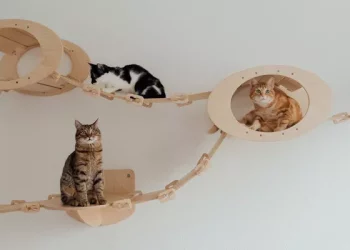Training pets is an enjoyable and rewarding experience for both the pet and the owner. For cat lovers, one breed that is often known for its intelligence and trainability is the American Shorthair. This breed, known for its easygoing nature, playful demeanor, and sharp mind, makes a great candidate for learning tricks. Whether you’re aiming to teach your American Shorthair how to sit, high-five, or even fetch, with patience, consistency, and the right techniques, you can have a cat that enjoys learning new skills.
In this article, we’ll explore how to train an American Shorthair to do tricks, step-by-step. By understanding their behavior, leveraging their natural instincts, and following structured methods, you’ll set both you and your pet up for success.
Understanding the American Shorthair Cat
Before diving into the specifics of training, it’s important to first understand the American Shorthair breed. Known for its friendly and adaptable temperament, the American Shorthair has a strong work ethic. Initially bred as a farm cat to catch mice, they are independent, intelligent, and quick learners. These traits make them excellent candidates for trick training.
While they are generally low-maintenance in terms of grooming and are known to be affectionate, American Shorthairs can also have a stubborn streak. This means that while they are capable of learning, they may need more motivation and patience compared to some other breeds. Understanding their personality traits will help you develop the best approach for teaching tricks.
Common Characteristics of the American Shorthair:
Friendly and Playful: These cats are very social and enjoy spending time with their human family members. This makes training an enjoyable experience for both parties.
Independent but Loyal: Though they enjoy affection, they are not overly clingy, which means they may prefer to train on their terms.
Intelligent and Curious: Their curiosity often leads them to explore new things. This natural inquisitiveness can be harnessed to help them learn new tricks.
Moderately Active: While not hyperactive, American Shorthairs do enjoy playtime and physical activity, which is helpful when training with rewards such as toys.
Preparing for Training
Before you start teaching your American Shorthair tricks, it’s essential to set the right environment and mindset for both you and your cat. Here are a few tips to prepare:
1. Create a Quiet, Distraction-Free Space
Cats are more likely to focus and learn when they are in an environment free from distractions. Choose a quiet room where you and your cat can focus on training without outside disturbances. Avoid high-traffic areas or spaces with loud noises that might distract your cat.
2. Gather the Right Tools
To train your American Shorthair, you’ll need a few essential items:
Treats: Use high-quality, small-sized treats that your cat enjoys. American Shorthairs are food-driven, so this will be a key motivator. Make sure the treats are soft and easy to chew, so your cat doesn’t lose interest.
Clicker: A clicker is an excellent tool for reinforcing positive behavior during training. The click sound provides immediate feedback that your cat has performed the correct action.
Toys: In addition to treats, toys can be used as rewards for training, particularly for tricks that involve physical activity, such as fetch or “sit”.
3. Establish a Routine
Cats thrive on routine, and the same applies to training. Try to train your American Shorthair at the same time each day. Short, consistent training sessions—no more than 5 to 10 minutes—are more effective than longer ones. Cats generally have short attention spans, so keeping the training sessions brief and fun will help your cat stay engaged.
4. Stay Patient and Positive
Like any animal, your American Shorthair will need time to grasp new concepts. Patience is key. Avoid using punishment or negative reinforcement. Instead, focus on rewarding positive behavior to create a positive learning experience.
Basic Training Steps
Now that you are prepared, let’s start with the basic steps of training. Below, we will cover a few essential tricks to teach your American Shorthair. These tricks will build a foundation for more advanced skills.
1. Training Your American Shorthair to Sit
One of the easiest tricks to teach any cat is “sit.” This trick is a great starting point because it helps your cat associate commands with actions, setting the stage for more complex tricks later on.
Step-by-Step Guide to Teach Sit:
Get Your Cat’s Attention: Hold a treat in your hand, letting your cat see it. You can use a toy as well to get your cat’s interest.
Move the Treat: Slowly move the treat over your cat’s head toward their back. As their head moves upward to follow the treat, their bottom will naturally lower into a sitting position.
Say the Command: As soon as their bottom touches the floor, immediately say “sit” in a calm and firm voice.
Reward Immediately: Give them the treat and praise them right away. This reinforces that the action they just performed was correct.
Repeat: Do this several times in short, consistent training sessions. Eventually, your cat will start sitting on command, even without the lure of the treat.
2. Training Your American Shorthair to High-Five
The “high-five” is a fun trick and relatively easy to teach once your cat is comfortable with basic commands.
Step-by-Step Guide to Teach High-Five:
Get Your Cat’s Attention: Just like the “sit” command, start by showing your cat a treat.
Lure Them to Touch Your Hand: Hold the treat in your hand, but instead of placing it directly in front of them, hold it slightly above their head or in front of your palm. Your cat will naturally reach up with their paw to touch it.
Reward the Paw Movement: As soon as your cat touches your palm with their paw, give them the treat and praise them enthusiastically.
Add the Command: After several repetitions, begin adding the command “high-five” just before your cat touches your hand. With enough practice, they’ll begin associating the word with the action.
3. Training Your American Shorthair to Fetch
This may sound like a more complicated trick, but many American Shorthairs are naturally inclined to chase objects, so fetching can be a relatively simple trick for them to learn.
Step-by-Step Guide to Teach Fetch:
Start with a Toy: Use a small toy or ball that your cat enjoys batting around.
Throw the Toy: Gently toss the toy a short distance away. Most cats will instinctively chase after it.
Encourage Retrieval: When your cat picks up the toy, call them back to you using a verbal cue like “bring it” or “fetch.” You can also use a treat to lure them back to you.
Reward the Action: As soon as your cat returns the toy or comes close to you with it, give them praise and a treat. If your cat doesn’t return it immediately, try offering the toy again to spark their interest.
Repeat and Reinforce: With repetition, your American Shorthair will start associating the toy with the fetch command and bringing it back to you. Keep the sessions short, fun, and rewarding to maintain their interest.
4. Training Your American Shorthair to Lie Down
The “lie down” trick is another great way to build on your cat’s obedience and is a useful command in many situations, such as during grooming or vet visits.
Step-by-Step Guide to Teach Lie Down:
Get Your Cat’s Attention: Start by having your cat sit in front of you.
Use a Treat: Hold a treat in your hand, and slowly lower it to the ground in front of your cat. As your cat follows the treat, their body will naturally lower to the floor.
Add the Command: As soon as your cat lies down, say the word “down” in a calm tone. Reward them immediately with praise and a treat.
Repeat the Process: Keep practicing this several times, using the command consistently. Over time, your cat will learn to associate the word with the action.
5. Training Your American Shorthair to Roll Over
“Roll over” is an advanced trick that builds on the “lie down” command. It’s a fun trick that is sure to impress your friends and family.
Step-by-Step Guide to Teach Roll Over:
Start with the Lie Down Command: Begin with your cat in a lying-down position.
Use a Treat: Hold the treat near your cat’s face and move it slowly toward their side. This should encourage them to turn their body to follow the treat.
Encourage the Full Roll: Once your cat is comfortable rolling halfway, continue guiding the treat to help them complete a full roll over.
Add the Command: Once your cat has mastered rolling over, start adding the command “roll over” just before they perform the action.
Reward and Repeat: Be sure to reward your cat immediately after each roll over and continue practicing until they can do it on command.
Troubleshooting Common Issues
While training your American Shorthair, you may encounter a few challenges. Here are some common problems and their solutions:
Lack of Interest: If your cat seems disinterested, try using different types of treats or toys to see what excites them. Make sure the training sessions are short and engaging.
Overstimulation: Some cats become overstimulated or frustrated during training. If this happens, stop the session and try again later. Always end on a positive note.
Inconsistent Behavior: Consistency is key in training. Be patient, and always use the same words, gestures, and rewards. Avoid using punishment or negative reinforcement.
Conclusion
Training an American Shorthair cat to do tricks can be a rewarding experience for both you and your pet. With their intelligence, playfulness, and desire to please, they are excellent candidates for learning a variety of fun and useful tricks. By using positive reinforcement, setting clear commands, and staying consistent with your training, you’ll soon have a cat that can show off impressive tricks like sitting, high-fiving, fetching, and rolling over.
Remember to be patient, keep the sessions short and enjoyable, and most importantly, celebrate your cat’s progress. With time, your American Shorthair will not only become a star performer but also strengthen the bond between you and your feline companion. Happy training!
Related Topics:
























